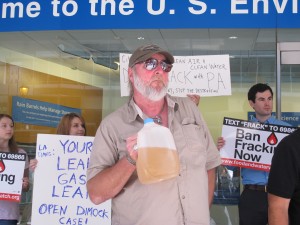Environmentalists Lead Push for EPA to Reopen Dimock Water Study
-
Katie Colaneri
Environmentalists from Pennsylvania will arrive in Washington, D.C. today with some 50,000 petitions calling for the U.S. Environmental Protection Agency to reopen a high-profile water contamination study.
The petitions, circulated online by Food and Water Watch and other environmental groups, come just two weeks after the Los Angeles Times reported that regional officials with the EPA in Philadelphia did not agree with the national office on its decision to close an investigation into water contamination in Dimock, Pa.
Environmental activists stopped by the mid-Atlantic office in Philadelphia Monday afternoon to drum up support.
In the middle, sporting silver aviator sunglasses, was Ray Kemble, one of several residents from Dimock who say nearby natural gas extraction has contaminated their drinking water supplies. Kemble has become a key figure in the fight against fracking in the Susquehanna County village.
Holding up a gallon jug of brown water taken from his well last December, Kemble said it’s even worse now.
“The smell is horrendous coming off the well. It’s so bad, it’ll start burning your nose, back of your throat. You’ll start gagging.”
The EPA study found hazardous levels of barium, arsenic or manganese in the water supplies of five households. But the agency said the toxins could be reduced to safe levels with treatment.
Last July, the EPA announced it had completed its investigation and that water in Dimock was safe to drink. An undated internal PowerPoint leaked to the Los Angeles Times shows at least one official at the mid-Atlantic office in Philadelphia linked contaminants found in the tested water to gas drilling.
“The presentation, based on data collected over 4 1/2 years at 11 wells around Dimock, concluded that “methane and other gases released during drilling (including air from the drilling) apparently cause significant damage to the water quality.” The presentation also concluded that “methane is at significantly higher concentrations in the aquifers after gas drilling and perhaps as a result of fracking [hydraulic fracturing] and other gas well work.”
The EPA did not respond to a request for comment, but a spokeswoman told the Times that it was only a “preliminary evaluation” by one coordinator in the region.
A 2009 study from the Pennsylvania Department of Environmental Protection also found high levels of methane in ten Dimock water wells and held the company, Cabot Oil and Gas responsible.
Cabot spokesman George Starck said the company would not support a new investigation and stood behind the EPA’s original findings.
“Methane is a pre-existing condition,” Starck said of the company’s own studies of Dimock’s aquifers. “In the 1800s, the gas was there.”
Environmentalists are concerned that support for natural gas development as high up as the Obama Administration is keeping these studies from reaching their full regulatory potential. Last spring, the EPA closed two other water contamination studies in Pavillion, Wyo. and Weatherford, Tx.
“I’ve gotten it from people off the record and I’m not going to say who they are, but we’re standing in front of the building, it’s coming from higher up,” Dimock resident Ray Kemble said. “It’s above their pay grade.”
Kemble is hopeful this new information about the EPA’s process in Dimock will move federal officials to take a new look at all contamination complaints in shale regions across the U.S.

















